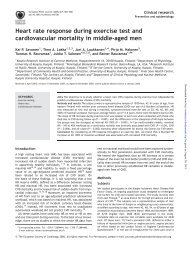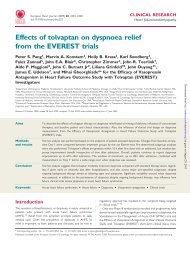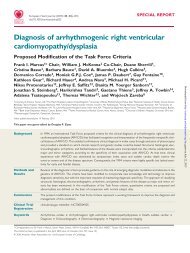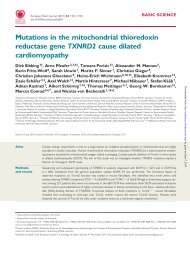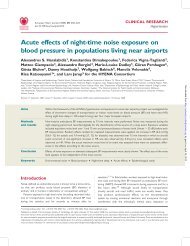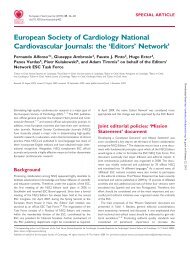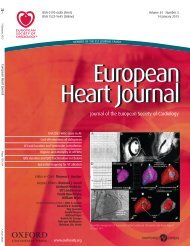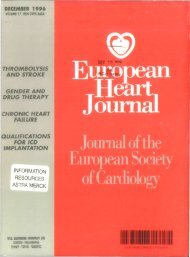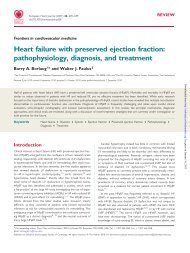Adjunctive manual thrombectomy improves myocardial perfusion ...
Adjunctive manual thrombectomy improves myocardial perfusion ...
Adjunctive manual thrombectomy improves myocardial perfusion ...
Create successful ePaper yourself
Turn your PDF publications into a flip-book with our unique Google optimized e-Paper software.
Manual <strong>thrombectomy</strong> devices to prevent distal embolization in AMI 3007<br />
Figure 2 <strong>Adjunctive</strong> <strong>manual</strong> <strong>thrombectomy</strong> devices and 30-day mortality, with odds ratios (OR) and 95% confidence intervals (CI). The size<br />
of the data markers (squares) is approximately proportional to the statistical weight of each trial.<br />
Figure 3 Funnel plot of all studies included in the meta-analysis. Sample size of each study was plotted against the odds ratio for 30-day<br />
mortality. No skewed distribution was observed, suggesting no publication bias.<br />
survival with <strong>manual</strong> <strong>thrombectomy</strong> but not other mechanical<br />
devices are strictly depending on device features and performance<br />
or the availability of larger number of trials, is still unknown.<br />
A large-scale controlled randomized trial with the AngioJet in<br />
thrombotic lesions in acute <strong>myocardial</strong> infarction (AMI) is currently<br />
underway in Europe, and will probably provide additional data on<br />
the benefits from mechanical <strong>thrombectomy</strong> devices.<br />
Limitations<br />
This meta-analysis was not performed on individual patient data, as<br />
complete data sets were not available. Caution should be exercised<br />
in the interpretation of the results, given the potential clinical<br />
heterogeneity among trials, due to varying inclusion criteria, definition<br />
of variables, and different <strong>manual</strong> <strong>thrombectomy</strong> devices.<br />
We could not include infarct size as endpoint of the current<br />
meta-analysis due to the unavailability of data and disparity in the<br />
measurement among studies [by enzymes, nuclear scintigraphy<br />
or MRI (magnetic resonance imaging)]. Even if several trials have<br />
not been published as full-length articles yet, a sensitivity analysis<br />
did not show any impact of the publication status on study<br />
results (Table 2). Finally, the large use of Gp IIb–IIIa inhibitors<br />
observed in the vast majority of trials (Table 1), has certainly minimized<br />
the risk of any potential overestimation of the benefits from<br />
thrombus aspiration.<br />
Conclusions<br />
The present meta-analysis has demonstrated that, among patients<br />
with STEMI undergoing primary PCI, the use of adjunctive<br />
Downloaded from<br />
http://eurheartj.oxfordjournals.org/ by guest on February 13, 2013



